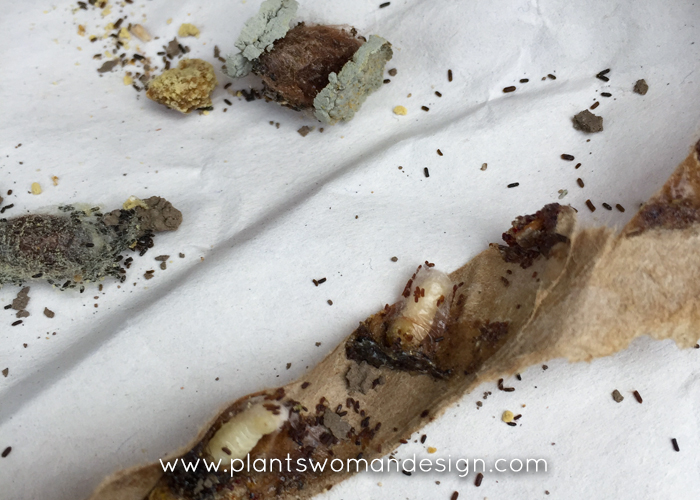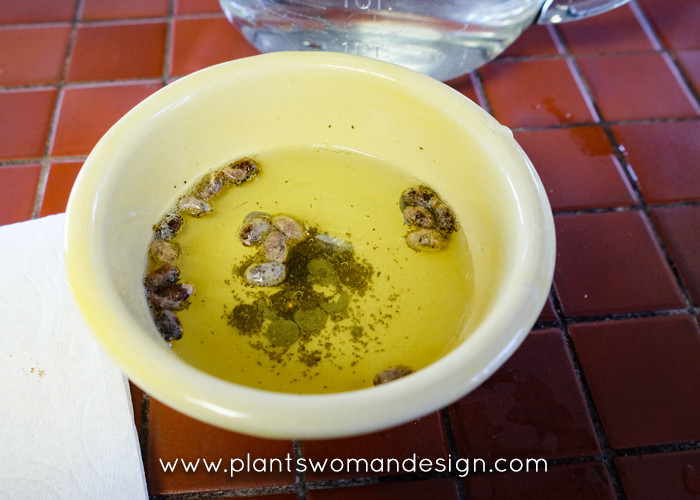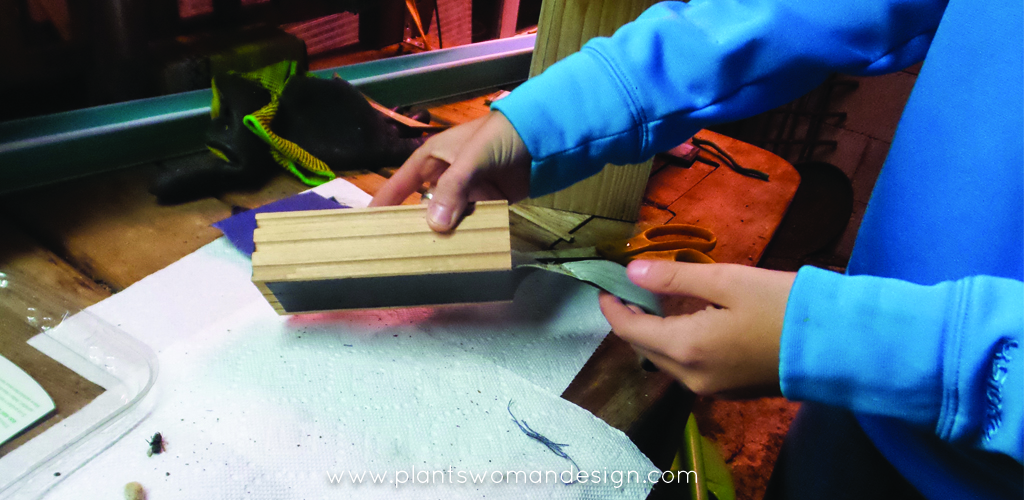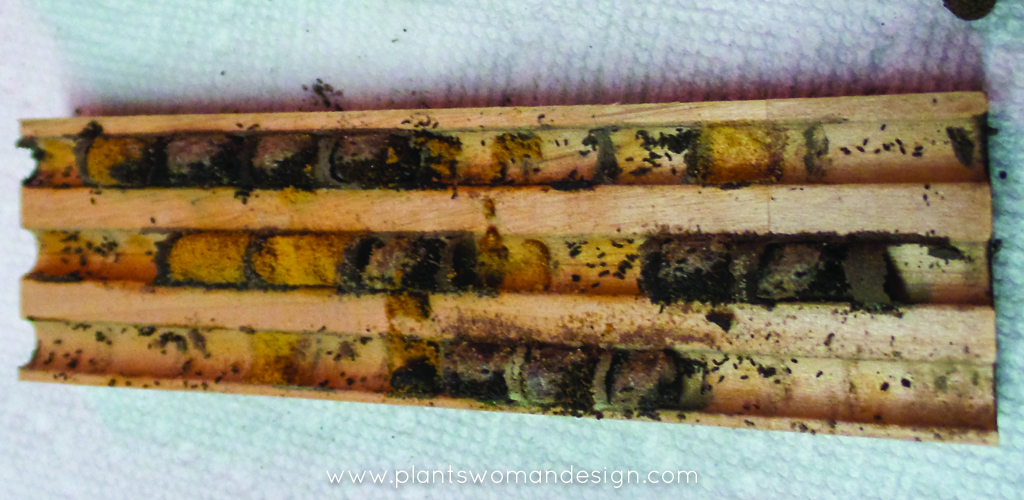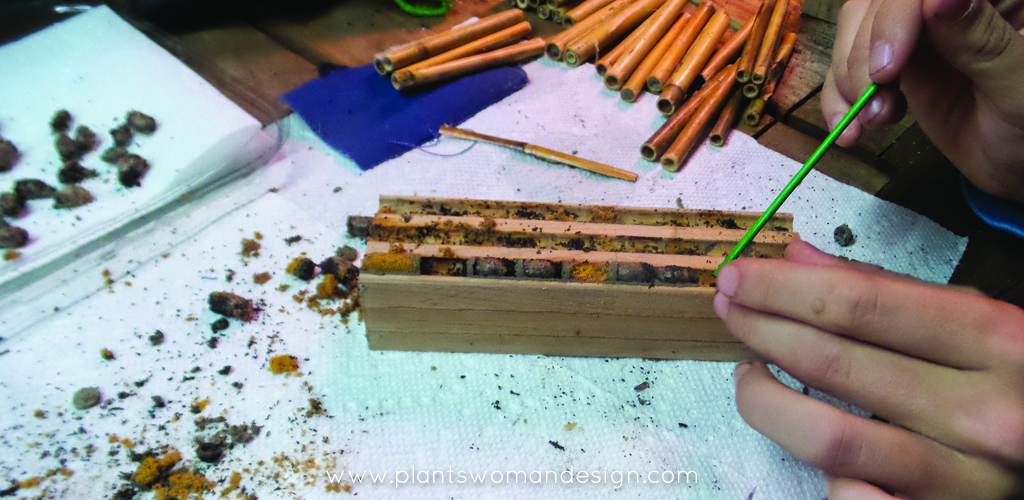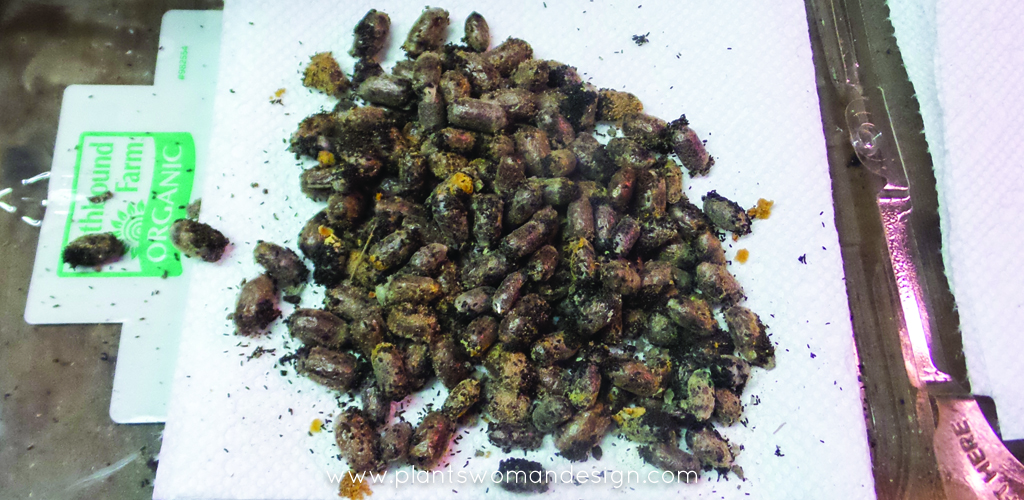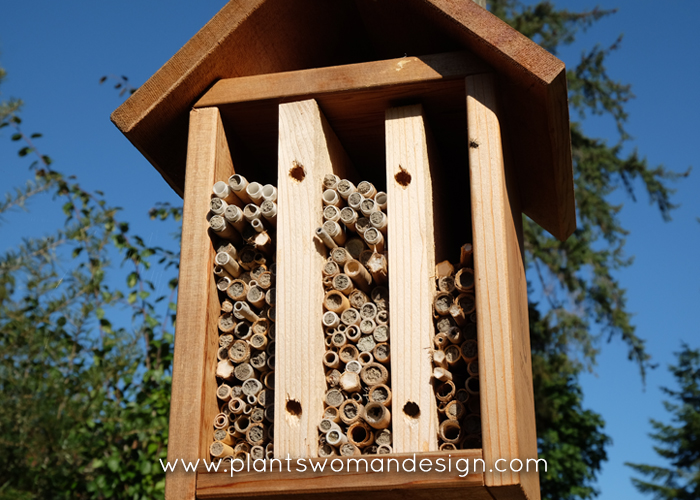
by Susan | Oct 13, 2017 | LB Tutorial: Garden Critters
It is time once again to harvest the Mason Bees. One of my bee houses is full this year, the other one not so much. I’m wondering if birds helped themselves to the cocoons before they had a chance to hatch out.
Last year I harvested about 100 bees. I gave some to my sister as her Christmas gift and put the rest back in the garden. The location near the vegetable garden was full of bees but the one by the apple tree was mostly empty. That is not to say there was no pollination. My apple trees were amazing this year.
Here are the things I observed this year.
Mason Bees will live in the bee houses but also in the ground. There is a sandy area by one of the vegetable beds that had many bees going in and out of all season long. They had created their own little colony in the ground. Remember these are Mason Bees so they don’t sting and aren’t aggressive.
If you see yellow and black wasps these are not mason bees. Those would be not good to have in a ground nest as they do sting and are aggressive.
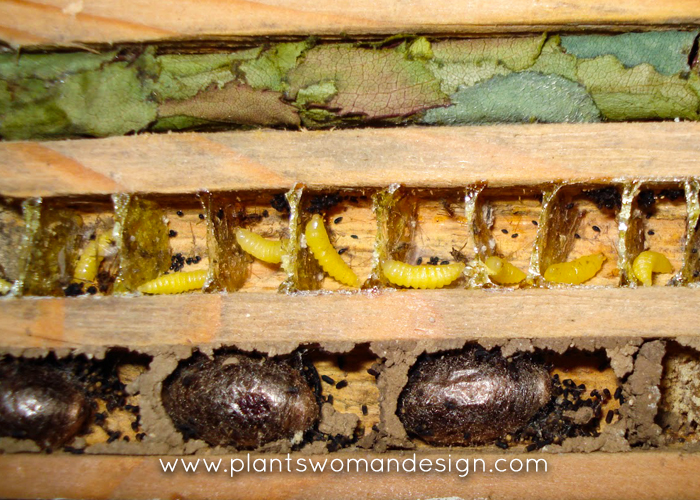
My first ever leaf cutter bees. (Megachilidae) I found bees going in the ground by the fountain pulling bits of leaves in with them. This was during July and August. Mason bees are going dormant by then and leaf cutter bees take over. You can purchase leaf cutter bees by mail order or in the nursery to help pollination continue throughout the year.
When I opened up my mason bee tubes I also found some little larvae in with them. They had pollen with them (the food for hatchlings). They are actually leaf cutter bees that have used the mason bee house for a home instead of making one out of leaves. I did not find these bees in the house last year and probably would have thought that they were not supposed to be there.
Cleaning the Cocoons:
Separate the tubes either by splitting the bamboo or unwrapping the paper tube. Carefully pull the cocoons from the tube and put on paper towel.
Prepare a solution of water with bleach. I use 1 tsp of bleach per 2 gallons of water.
Drop the cocoons in the water and swish around gently for several minutes. The debris will drop to the bottom and cocoons will be mostly clean. If there is a little pollen (yellow dust) on them I don’t worry about it.
Rinse twice in clean water with about 5 minutes of washing time.
Spread on a paper towel to dry.
Pack into a plastic tray with paper towel under the babies. Mist gently with water and poke some holes in the tray for air circulation.
AS they rest in the refrigerator over the winter (or consistently cool 45 degrees) or shed outside. Mist them occasionally so they don’t dry out.
It is a privilege to share the word about bees that are so important for pollination. Remember: Native bees are 100 times more effective at pollination than honey bees. This makes a big difference in the production of the food we all eat.
Be sure to catch up on our Mason Bee journey by clicking on the blog posts below.

by Susan | Oct 21, 2016 | LB Tutorial: Garden Critters
This has been a good year for my mason bees and they were fabulous in my garden. The apple trees were loaded with fruit and the veg garden did well. Now It is time to harvest the bees again this year. One of things I did different this year was to use cardboard tubes along with the wooden trays. The tubes were added next to the tray in the house. They were a little hard to get out because they were wet and swollen with rain. The little bees also went behind the nesting block and built quite a metropolis out of mud. Not having seen this before I was a little worried about the possibility of mud houses being wasps instead of bees. A quick call to Crown Bees assured me that these were industrious bees that created a little adobe home because they ran out of room in the tubes. The solution? More tubes of course. I had already tripled the number from last year!
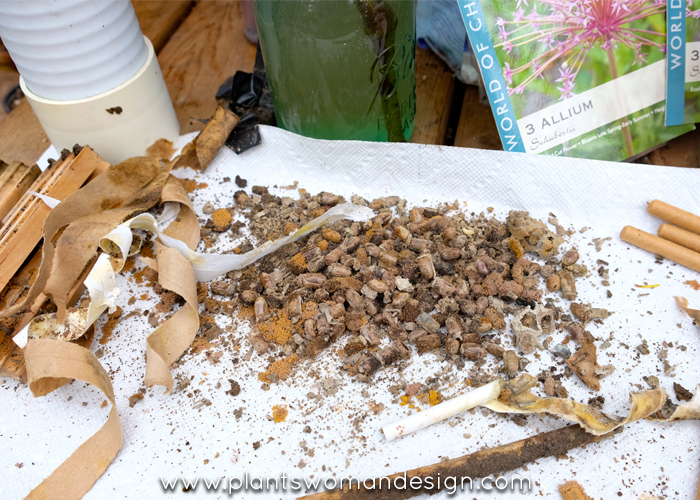
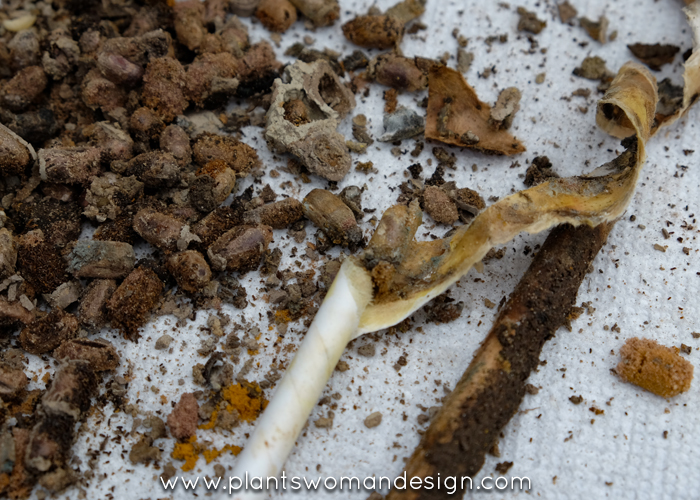
A few little known facts about mason bees (or maybe they aren’t):
Yes, you should harvest the bees every year. Pollen mites will eat pollen then attach themselves to the bee and be reintroduced to the tubes when they come back to lay eggs. Harvesting them assures clean tubes and no mites on the cocoons.
Yes, you can have two harvests each year. When the tubes fill up in the summer you can pull them out and put in clean ones. It won’t be quite time to actually harvest them so
Crown Bees recommends hanging them outside in a
Bee Guardian Bag so they have the warmth to mature but are protected from predators.
No, don’t use drilled wood, plastic straws, or bamboo straws. These are hard to clean and harvest the bees. If you have some already there is a special technique using a paper bag that allows them to leave the nesting material and not be able to come back to it. Providing the new tubes nearby will insure that they will move into the new accommodations instead of old nesting material.
No, one size does not fit all. Crown Bees is now selling different sized tubes to encourage small native bees to nest with the other bees. They are hearing from other gardeners about the bees that are nesting in smaller holes and now provide good nesting material to encourage native bees to hang out with the ones you bought or the community that you are fostering each year.
Mason Bees: bee keeping made easy, and stingless. Everyone should get involved.
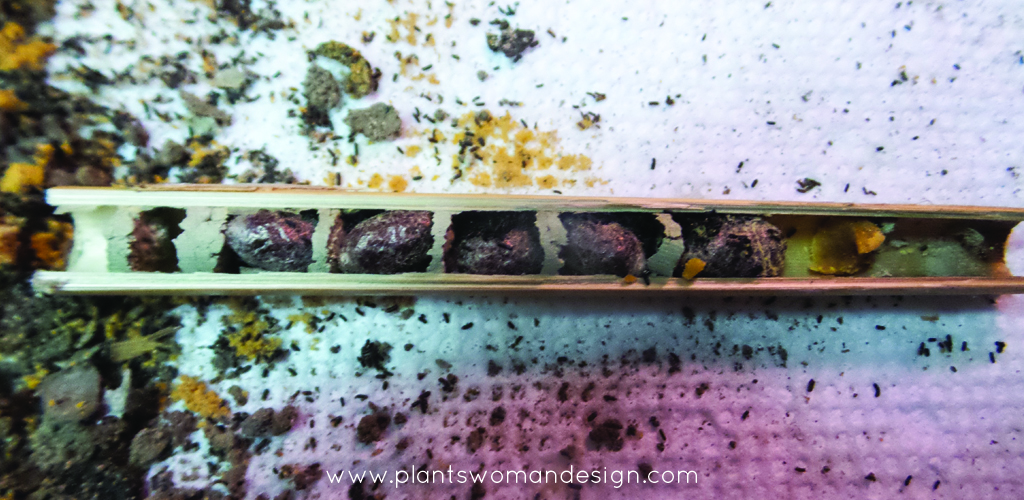
by Susan | Oct 30, 2015 | LB Tutorial: Garden Critters
Winter is just around the corner and it is time to harvest my Mason Bees. Not everybody does a harvest but for the best life expectancy constant winter temperature is important.
First some help with the bee removal from my Granddaughter Kayla. We took apart the block of bees and separated all the material in the tubes. There were bees, pollen, mud, and feces. We had a couple of different type of tubes. The bamboo tubes have to be separated by cutting into one end and the breaking the tube apart.
We carefully pulled out the cocoons and threw away the mud plugs and rest of the debris. There are two sizes of bees. The bigger ones are the females and the smaller ones are males. There are some empty cocoons, these can be from pests, or the bee wasn’t good at building the cocoon.
In the pictures you can see some pollen and also some big sections of orange looking pollen. I think this might be mites so I will clean the cocoons with sand to get rid of the mite debris around the cocoons. Usually the mites will not really affect the bees when they are not in the tube but better to be safe than sorry.

After they are clean I will put them in a plastic produce box with a little moist paper towel in the bottom. It will stay in the refrigerator until next spring when the weather warms and then back they will go out into the mason bee house to pollinate again.
The most interesting things are the many small cocoons that are also in the tubes. These are likely native solitary bees that made a home in the bee house too. There are over 130 different varieties of bees in the garden. These will be stored with the mason bees. There are some tubes that are permanent in the house and they will stay outside until the bees come out of hibernation and they will make their own way out.
I’m excited that I have so many more bees than I put out last spring. Quite a harvest!
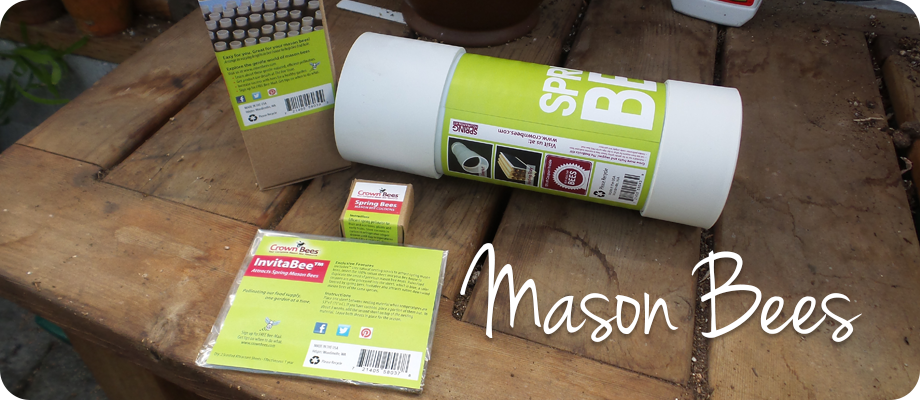
by Susan | Mar 15, 2015 | LB Tutorial: Garden Critters
Back in February we wrote about Mason Bees and the tremendous job they do pollinating the garden. With our warm weather starting early this year I purchased my kit from my local nursery, Valley Nursery, two weeks ago. The guidelines say to wait until it is 53 degrees and warming in the daytime. It has been getting up to 58 – 59 in the daytime and yesterday was even warmer so I’m going to put my bees out.
 This is the Crown Bee Kit I purchased. The bees come separate so you can get more If needed. I had a hard time deciding where to put the nesting box. It needed to be where the sun would hit it early in the day to warm them, not near predators (birds mostly), and within 300 feet of a mud/water source. Wanting to see them in action I placed it on a post at eye level next to my vegetable garden plot behind the green house. Mason bees need a ready food source (something blooming) when they emerge. The espaliered fruit trees are almost ready to bloom so they will be available for early food for the bees along with the Forsythia, hellebores, and Indian plum (oemleria cerasiformis) blooming now.
This is the Crown Bee Kit I purchased. The bees come separate so you can get more If needed. I had a hard time deciding where to put the nesting box. It needed to be where the sun would hit it early in the day to warm them, not near predators (birds mostly), and within 300 feet of a mud/water source. Wanting to see them in action I placed it on a post at eye level next to my vegetable garden plot behind the green house. Mason bees need a ready food source (something blooming) when they emerge. The espaliered fruit trees are almost ready to bloom so they will be available for early food for the bees along with the Forsythia, hellebores, and Indian plum (oemleria cerasiformis) blooming now.
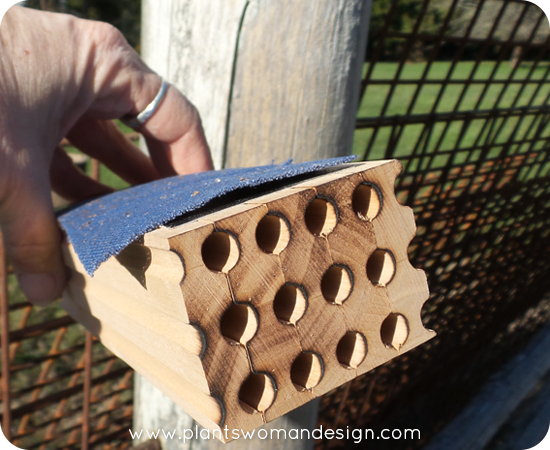 Following the directions, I placed the lid on the post and used screws to attach it. I left the top screw out a little and tightened the bottom one so there was a little slant. This helps to protect the home from rain. However, the downward slant can’t be too great or the block of nesting holes will fall out.When the tube was attached , I took off the clear plastic cover, slid the block inside and put the bee attractant, which helps the bees find their home when they first emerge, on the top.
Following the directions, I placed the lid on the post and used screws to attach it. I left the top screw out a little and tightened the bottom one so there was a little slant. This helps to protect the home from rain. However, the downward slant can’t be too great or the block of nesting holes will fall out.When the tube was attached , I took off the clear plastic cover, slid the block inside and put the bee attractant, which helps the bees find their home when they first emerge, on the top.
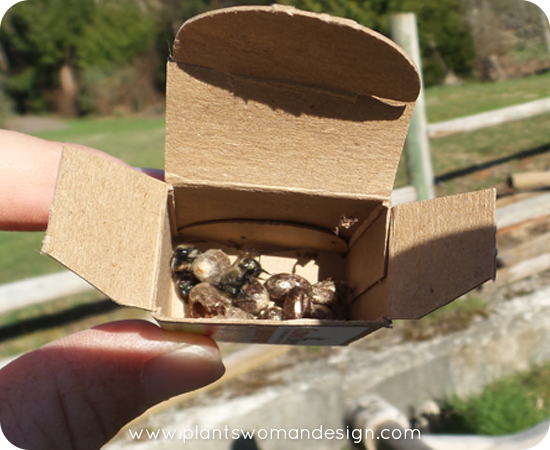 When I opened the box of bees, it was so exciting to see that a couple of the bees had already emerged from their cocoon! I could see them sleeping in there.
When I opened the box of bees, it was so exciting to see that a couple of the bees had already emerged from their cocoon! I could see them sleeping in there.
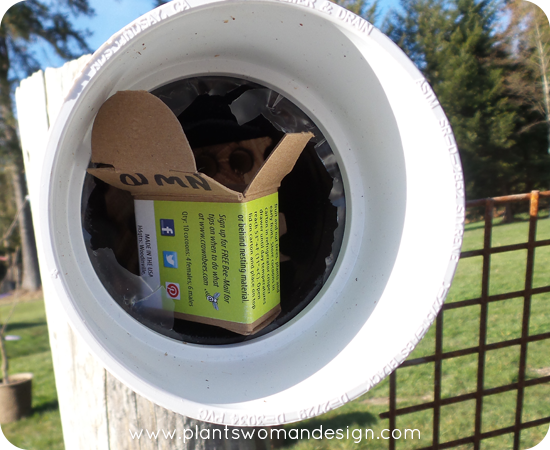 I placed the box near the opening so as they emerged they would see the nesting box. When I checked the next day I saw two bees flying around the box.
I placed the box near the opening so as they emerged they would see the nesting box. When I checked the next day I saw two bees flying around the box.
I want to build another box this weekend and try out the straws I bought. Straws are an alternative nesting material for mason bees that are disposable. When the season is over, the straws are taken apart to harvest the bee cocoons. The box I have now can be taken apart and cleaned after harvesting the new bee cocoons. The instructions recommend taking the cocoons out in the fall and storing them inside a refrigerator or cold shed until spring arrives to start the process again. Removing the cocoons and storing them protects them from predators in the winter.
Are you jumping into Mason Bees with us? We want to hear about it! Leave a comment below or follow us on Facebook.
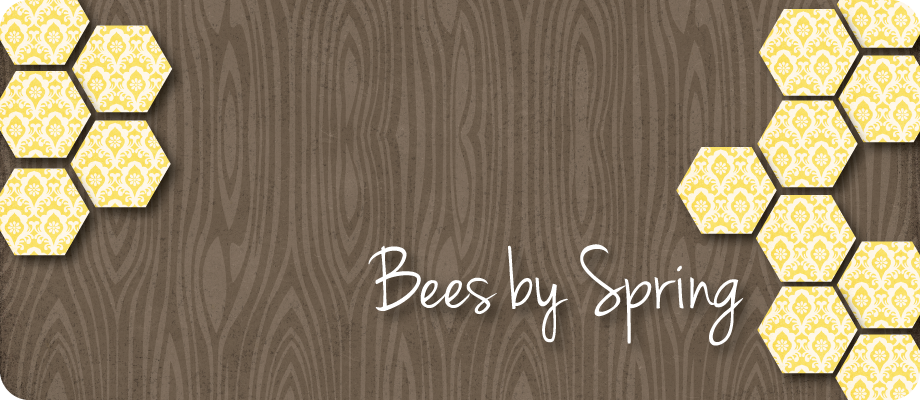
by Kristen | Sep 17, 2014 | Plantswoman Design
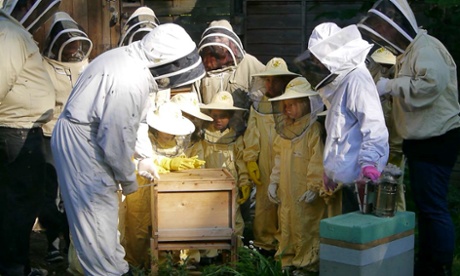
Urban Bees in the UK
As summer is winding down we are already looking ahead to early next spring and making plans… for bees!!! Mason bees to be exact. You may be ‘so over’ having bees as unwanted guests pestering you through out your outdoor endeavors. We were inundated at an outdoor morning picnic recently to the point we had to start moving the food inside. “Be careful of the wasps”, “don’t make them mad” and the ever popular “they are more afraid of you than you are of them” comments were aplenty through out the affair. But there is some confusion about bees and, before we went on a bee adventure ourselves, we wanted to find out what the deal was. So here we go…
Are all bees wasps?
No, but the term “wasp” incorporates a number of different, predatory groups such as hornets and yellow jackets.
Are bees and wasps really more afraid of me than I am of them?
Not likely, their main objective is to gather food for and protect their hive. If you are in their way they will defend what is theirs. Wasps may be more aggressive than other bees but the goal is still the same. If they were afraid of you they would likely want to be far away from you rather than continuing to pursue you and your food.
What’s the main difference between bees and wasps?
Bees, that collect nectar and are major player amongst pollinators, typically have fuzzy bodies that readily hold onto the pollen the bee comes into contact with. Wasps on the other hand don’t have a great deal of fuzz on their bodies and therefore aren’t great pollinators. Wasps, instead, prey on other insects for their food. So, if you think spraying insecticides on your garden to get rid of wasps is a good idea think twice. Besides being illegal, you are likely harming innocent pollinators rather than the often more aggressive perpetrator, wasps.
Bee keeping is growing in popularity especially amongst urban homesteaders and urban community gardens. There are many valuable resources out there to get you started if you are interested. The Plantswoman will be getting her bees in the spring and we will be sure to share our progress here on the blog. In the meantime, have patience with these flying friends. They are needed.





